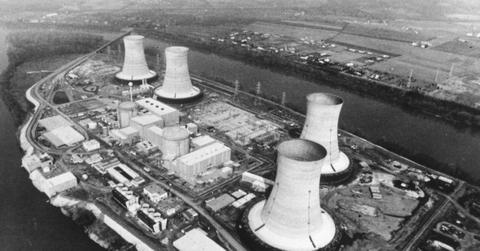Who Owns Three Mile Island? Site of 1979 Nuclear Plant Accident
Netflix has made a four-part documentary on the Three Mile Island nuclear plant accident. Who owns Three Mile Island now? The accident happened in 1979.
May 4 2022, Published 9:14 a.m. ET
While there have been several nuclear reactor accidents in the U.S., none comes closer to Three Mile Island. The incident happened in 1979 but many people still think about it. Netflix has made a four-part documentary on the accident, which is premiering on May 4, called Meltdown: Three Mile Island. What happened at the Three Mile Island nuclear plant and who owns the nuclear reactor stations now?
First, unlike incidents like Chernobyl in the former Soviet Union and Fukushima in Japan, the meltdown at Three Mile Island, fortunately, didn't lead to the loss of lives. However, it's still seen as a major moment in U.S. nuclear energy history because it stalled several nuclear plants. The country’s reliance on fossil fuels increased over the next few years.
There were two nuclear reactor stations on Three Mile Island.
There were two nuclear reactor stations on Three Mile Island. There was the Three Mile Island Generating Station Unit 1 (TMI-1) and the Three Mile Island Generating Station Unit 2 (TMI-2). Three Mile Island is located in Londonderry Township, Pa., on Lake Frederic.

Construction on TMI-1 began in May 1968 and it started functioning in 1974. As for the TMI-2, the construction began in November 1969 and it started operating in 1978. The accident occurred at the TMI-2.
Who owns the nuclear plants on Three Mile Island?
The TMI-2, where the unfortunate incident occurred, was owned by . However, in December 2020, the company sold it to Energy Solutions and completed the decommissioning process. The TMI-1 is owned by Constellation Energy and the company purchased the unit in 2000.
According to Constellation, the plant was producing 800 megawatts of electricity and in almost two decades of functioning under its leadership, the plant offset over 95 million metric tons of carbon.
Three Mile Island has stopped operating now.
The TMI-2 stopped operating in 1979 after the accident. However, it took 12 years for the decontamination exercise at the reactor. The TMI-1 also closed in September 2019. The plant wasn't economically viable and had to eventually shut down. The process of decommissioning the nuclear plant is underway and could take decades.
What happened at TMI-2?
According to the USNRC (the United States Nuclear Regulatory Commission), the meltdown happened “when the plant experienced a failure in the secondary, non-nuclear section of the plant.” A fault occurred that stopped the main feedwater pumps from sending water to the steam generators.
As a result, the plant's turbine-generator and the reactor automatically shut down. The pilot-operated relief valve opened to control the pressure in the primary system. However, even when the pressure came down, the valve didn't close. The control room showed that the valve was closed and the staff didn't realize that steam was coming out of that.
The reactor coolant pumps had to be shut down after they started vibrating. The USNRC noted, “Without the reactor coolant pumps circulating water and with the primary system starved of emergency cooling water, the water level in the pressure vessel dropped and the core overheated.”
There was a radiation leak during the Three Mile Island accident.
The USNRC notes that several studies have shown that the radiation leak from the plant to the around 2 million people near the TMI-2 was below the amount of exposure from a chest X-ray. The USNRC said that “comprehensive investigations and assessments by several well-respected organizations, such as Columbia University and the University of Pittsburgh, have concluded that in spite of serious damage to the reactor, the actual release had negligible effects on the physical health of individuals or the environment.”

